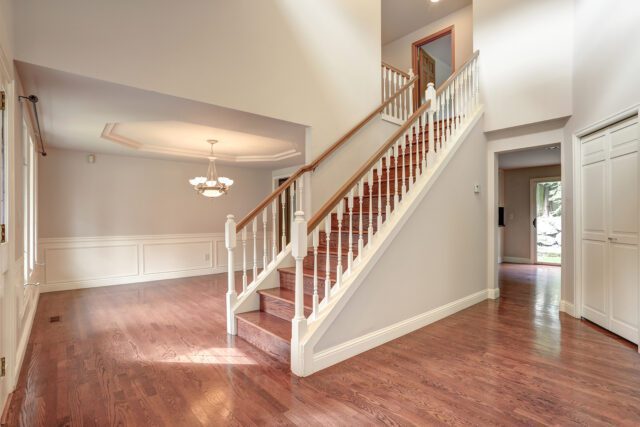With so many homes for sale, it’s easy to find newly renovated spaces on the market. Many older homes have outdated flooring that needs urgent updates. If you’re a new homeowner, you may not know where to begin this process. We’re going to walk you through the steps you should take when looking into replacing an old floor.
Types Of Flooring
When talking about flooring in homes, there are tons of different flooring methods that have come into and gone out of style over the decades. These include any of the following:
- Hardwood flooring
- Laminate flooring
- Tile flooring
- Carpet
These types of flooring can come in a variety of styles and materials depending on the use case. For example, bathroom tile flooring tends to be geared towards water resistance, where kitchen tile flooring can be geared towards heavy use.
Laminate flooring was traditionally meant to mimic tile, but has evolved to now mimic hardwood flooring instead. Carpet was often used on stairs and in living rooms, but we’ve seen it slowly replaced with hardwood and area rugs instead.
Knowing what type of flooring you’re looking to replace can help guide you in the right direction when looking for the replacement. If you’re looking to replace carpet, you likely want to go with hardwood. If you’re trying to replace tile, you’re probably going to replace it with something water resistant.

Why Replace Old Floor
You may want to replace your old floor for a range of reasons, but usually people replace the floor because it’s falling apart or because it doesn’t look good. A common problem in older tile flooring is the asbestos adhesive used to keep it in place. This tile needs to be pulled up by a professional in combination with a mold abatement company to ensure the rest of your house doesn’t get covered in asbestos adhesive.
There’s always a chance that the floor is a gorgeous floor, but it’s in poor condition. You see this a lot in houses with hardwood floors. More often than not, these hardwood floors hold up long after their installation and just need to be refinished. D&M Flooring offers hardwood floor restoration to bring your hardwood flooring back to life.
Hidden Floors
As the styles of flooring changed, people would adjust their floors to keep up with the times. That doesn’t always mean that they would pull their old floor up and put a new one down. Occasionally, it was cheaper to put the new floor directly over the old ones. This usually manifested itself in one of two ways:
Carpet, linoleum, or vinyl would be placed over an older hardwood floor. This would keep it relatively well preserved, giving the new homeowners a quick path to a nice floor via refinishing.
The less savory way this happened was covering up asbestos adhesive tiles or an absolutely ruined wood floor, which meant pulling up two floors when you were ready to replace them. Occasionally this was coupled with shoe moulding, which was one extra thing to pull up.
How To Proceed
When looking into replacing a floor, it’s important to identify the type of flooring you’re removing, as you may need professional help to remove it safely. In the case of hardwood floors, you may not need to remove the flooring at all, just refinish it.
If you have a second floor beneath your visible floor, you should decide whether you want to keep it or rip it up. In the case of hardwood floors, you’ll likely want to try to keep it by refinishing it.
Once you’ve determined your course of action, you should look to hire a professional to refinish old or install new floors. D&M Hardwood Flooring in Cranston RI has you covered. We specialize in installing all types of flooring, from hardwood to vinyl. We also refinish existing hardwood floors, staircases, and decks. Give us a call at (401) 304-6530 or visit our website here.

